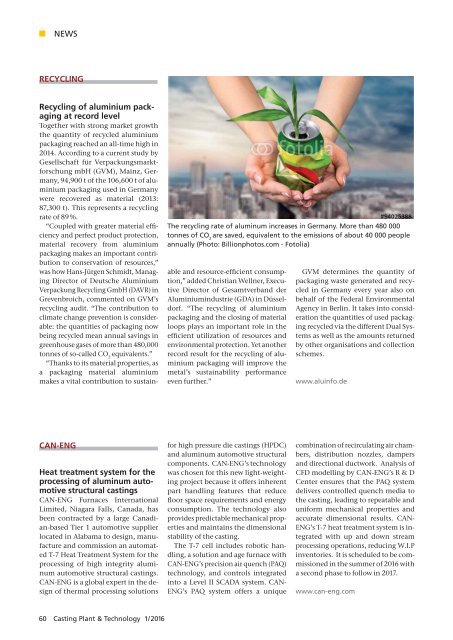CPT International 01/2016
The leading technical journal for the global foundry industry – Das führende Fachmagazin für die weltweite Gießerei-Industrie
The leading technical journal for the
global foundry industry – Das führende Fachmagazin für die
weltweite Gießerei-Industrie
You also want an ePaper? Increase the reach of your titles
YUMPU automatically turns print PDFs into web optimized ePapers that Google loves.
NEWS<br />
RECYCLING<br />
<br />
tonnes of CO 2<br />
are saved, equivalent to the emissions of about 40 000 people<br />
annually (Photo: Billionphotos.com - Fotolia)<br />
Recycling of aluminium packaging<br />
at record level<br />
Together with strong market growth<br />
the quantity of recycled aluminium<br />
packaging reached an all-time high in<br />
2<strong>01</strong>4. According to a current study by<br />
Gesellschaft für Verpackungsmarktforschung<br />
mbH (GVM), Mainz, Germany,<br />
94,900 t of the 106,600 t of aluminium<br />
packaging used in Germany<br />
were recovered as material (2<strong>01</strong>3:<br />
87,300 t). This represents a recycling<br />
rate of 89 %.<br />
“Coupled with greater material efficiency<br />
and perfect product protection,<br />
material recovery from aluminium<br />
packaging makes an important contribution<br />
to conservation of resources,”<br />
was how Hans-Jürgen Schmidt, Managing<br />
Director of Deutsche Aluminium<br />
Verpackung Recycling GmbH (DAVR) in<br />
Grevenbroich, commented on GVM’s<br />
recycling audit. “The contribution to<br />
climate change prevention is considerable:<br />
the quantities of packaging now<br />
being recycled mean annual savings in<br />
greenhouse gases of more than 480,000<br />
tonnes of so-called CO 2<br />
equivalents.”<br />
“Thanks to its material properties, as<br />
a packaging material aluminium<br />
makes a vital contribution to sustainable<br />
and resource-efficient consumption,”<br />
added Christian Wellner, Executive<br />
Director of Gesamtverband der<br />
Aluminiumindustrie (GDA) in Düsseldorf.<br />
“The recycling of aluminium<br />
packaging and the closing of material<br />
loops plays an important role in the<br />
efficient utilization of resources and<br />
environmental protection. Yet another<br />
record result for the recycling of aluminium<br />
packaging will improve the<br />
metal’s sustainability performance<br />
even further.”<br />
GVM determines the quantity of<br />
packaging waste generated and recycled<br />
in Germany every year also on<br />
behalf of the Federal Environmental<br />
Agency in Berlin. It takes into consideration<br />
the quantities of used packaging<br />
recycled via the different Dual Systems<br />
as well as the amounts returned<br />
by other organisations and collection<br />
schemes.<br />
www.aluinfo.de<br />
CAN-ENG<br />
Heat treatment system for the<br />
processing of aluminum automotive<br />
structural castings<br />
CAN-ENG Furnaces <strong>International</strong><br />
Limited, Niagara Falls, Canada, has<br />
been contracted by a large Canadian-based<br />
Tier 1 automotive supplier<br />
located in Alabama to design, manufacture<br />
and commission an automated<br />
T-7 Heat Treatment System for the<br />
processing of high integrity aluminum<br />
automotive structural castings.<br />
CAN-ENG is a global expert in the design<br />
of thermal processing solutions<br />
for high pressure die castings (HPDC)<br />
and aluminum automotive structural<br />
components. CAN-ENG’s technology<br />
was chosen for this new light-weighting<br />
project because it offers inherent<br />
part handling features that reduce<br />
floor space requirements and energy<br />
consumption. The technology also<br />
provides predictable mechanical properties<br />
and maintains the dimensional<br />
stability of the casting.<br />
The T-7 cell includes robotic handling,<br />
a solution and age furnace with<br />
CAN-ENG’s precision air quench (PAQ)<br />
technology, and controls integrated<br />
into a Level II SCADA system. CAN-<br />
ENG’s PAQ system offers a unique<br />
combination of recirculating air chambers,<br />
distribution nozzles, dampers<br />
and directional ductwork. Analysis of<br />
CFD modelling by CAN-ENG’s R & D<br />
Center ensures that the PAQ system<br />
delivers controlled quench media to<br />
the casting, leading to repeatable and<br />
uniform mechanical properties and<br />
accurate dimensional results. CAN-<br />
ENG’s T-7 heat treatment system is integrated<br />
with up and down stream<br />
processing operations, reducing W.I.P<br />
inventories. It is scheduled to be commissioned<br />
in the summer of 2<strong>01</strong>6 with<br />
a second phase to follow in 2<strong>01</strong>7.<br />
www.can-eng.com<br />
60 Casting Plant & Technology 1/2<strong>01</strong>6


















